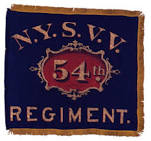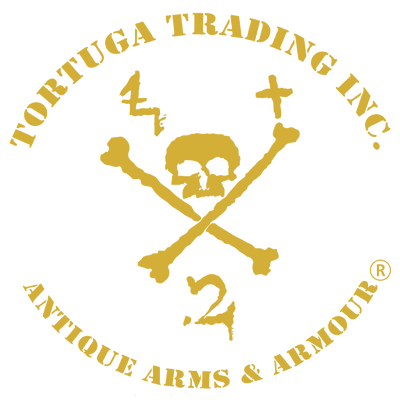A Good Antique Civil War Period Engraved Powder Horn of Union 2nd Lieutenant Ernest Kinney 54th New York Volunteers 1863
 Civil War Period
Civil War Period
A Good Antique Civil War Period Engraved Powder Horn, dated "1863". The powder horn measures 9.5" overall and has very high-quality engraving. The engraving consists of two banners and within "2 LT. ERNEST KINNEY", "54 N.Y. VOLs 1863" over a wonderful American Eagle with shield and clutching arrows in one talon and the olive branch in the other. The horn was fitted with a brass nozzle (just like those of powder flasks of the period) with an intact spring and functioning gate. A fantastic example !
Note: It is my opinion that this horn and the engraving upon it is genuine to the period as described. This style of engraved powder horn originated in colonial America in the mid-18th century and ended after the Civil War when black powder muzzle loading weapons were being replaced by more modern firearms.
Ref. Google Search on "2nd Lieutenant Ernest Kinney 54th New York Volunteers"
KINNEY , ERNES T L.—Enrolled to serve three years, and mustered in as second lieutenant, Co. I, January 9, 1863; discharged, November 11, 1864. Commissioned second lieutenant, January 9, 1863, with rank from same date, vice C. Hartmann, resigned.
TTI-549221
Ref. Wikipedia
54th New York Infantry Regiment

The 54th New York Infantry Regiment (aka "Schwarze Yaeger" or "Hiram Barney Rifles") was an infantry regiment in the Union Army during the American Civil War.
Service
The 54th New York Infantry was organized in Hudson, New York beginning August 30, 1861 and mustered in September 5, 1861 through October 16, 1861 under the command of Colonel Eugene A. Kozlay.
The regiment was attached to Provisional Brigade, Casey's Division, Army of the Potomac, to December 1861. Steinwehr's Brigade, Blenker's Division, Army of the Potomac, to March 1862. Steinwehr's 2nd Brigade, Blenker's 2nd Division, II Corps, Army of the Potomac, to April 1862. 2nd Brigade, Blenker's Division, Department of the Mountains, to June 1862. 2nd Brigade, 3rd Division, I Corps, Army of Virginia, to September 1862. 2nd Brigade, 3rd Division, XI Corps, Army of the Potomac, to November 1862. 1st Brigade, 1st Division, XI Corps, to August 1863. 1st Brigade, Gordon's Division, Folly Island, South Carolina, X Corps, Department of the South, to April 1864. Folly Island, South Carolina, Northern District, Department of the South, to October 1864. 1st Separate Brigade, Morris Island, South Carolina, Department of the South, to July 1865. 3rd Sub-District, Department of the South, to August 1865. 1st Brigade, Department of the South, to April 1866.
The 54th New York Infantry ceased to exist on December 21, 1862 when it was consolidated with the 38th New York Infantry as Companies G, H, I, and K.
Detailed service
Left New York for Washington, D.C., October 29. 1861. Duty in the defenses of Washington, D.C., until April 1862. Movement to Winchester, Va., April 5–18. Operations in the Shenandoah Valley until June. Battle of Cross Keys June 8. At Sperryville July 7 to August 8. Battle of Cedar Mountain August 9. Pope's Campaign in northern Virginia August 16-September 2. Fords of the Rappahannock August 20–23. Sulphur Springs August 26–27. Battle of Groveton August 29. Second Battle of Bull Run August 30. Duty in the defenses of Washington. D.C., until November. Movement to Centreville November 1–19. Waterloo Bridge November 7. Reconnaissance to Snicker's Ferry and Berryville November 28–30. Movement to Fredericksburg December 9–15. "Mud March" January 20–24, 1863. At Stafford Court House until April 27. Chancellorsville Campaign April 27-May 6. Battle of Chancellorsville May 1–5. Gettysburg Campaign June 11-July 24. Battle of Gettysburg July 1–3. Ordered to the Department of the South August 1. Siege of Forts Wagner and Gregg, Morris Island, and operations against Fort Sumter and Charleston August 9-September 7. Operations against Charleston and duty on Folly and Morris Islands, S.C., until June 1865. Expedition to John's and Islands February 6–14, 1864. James Island and October 24, 1864. Santee River February, serving duty in the District of South Carolina, Department of the South, until April 1866.
Casualties
The regiment lost a total of 142 men during service; 2 officers and 38 enlisted men killed or mortally wounded, 1 officer and 101 enlisted men died of disease.
Commanders
- Colonel Eugene A. Kozlay
- Lieutenant Colonel Charles Ashby - commanded at the Second Battle of Bull Run and at the Battle of Chancellorsville where he was captured
- Major Stephen Kovacs - commanded at the Battle of Chancellorsville after Ltc Ashby was captured; commanded at the Battle of Gettysburg where he was captured on July 1
- Lieutenant Ernst Both - commanded at the Battle of Gettysburg after Maj Kovacs was captured












